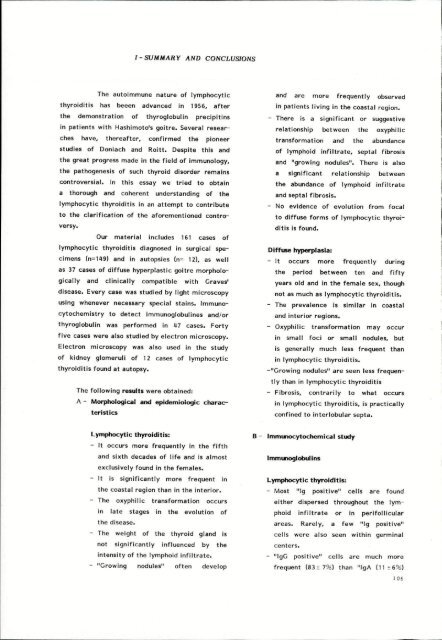Tireoidite linfocítica - Repositório Aberto da Universidade do Porto
Tireoidite linfocítica - Repositório Aberto da Universidade do Porto
Tireoidite linfocítica - Repositório Aberto da Universidade do Porto
You also want an ePaper? Increase the reach of your titles
YUMPU automatically turns print PDFs into web optimized ePapers that Google loves.
I-SUMMARY AND CONCLUSIONS<br />
The autoimmune nature of lymphocytic<br />
thyroiditis has beeen advanced in 1956, after<br />
the demonstration of thyroglobulin precipitins<br />
in patients with Hashimoto's goitre. Several resear<br />
ches have, thereafter, confirmed the pioneer<br />
studies of Doniach and Roitt. Despite this and<br />
the great progress made in the field of immunology,<br />
the pathogenesis of such thyroid disorder remains<br />
controversial. In this essay we tried to obtain<br />
a thorough and coherent understanding of the<br />
lymphocytic thyroiditis in an attempt to contribute<br />
to the clarification of the aforementioned contro<br />
versy.<br />
Our material includes 161 cases of<br />
lymphocytic thyroiditis diagnosed in surgical spe<br />
cimens (n=U9) and in autopsies (n= 12), as well<br />
as 37 cases of diffuse hyperplastic goitre morpholo<br />
gically and clinically compatible with Craves'<br />
disease. Every case was studied by light microscopy<br />
using whenever necessary special stains. Immuno-<br />
cytochemistry to detect immunoglobulines and/or<br />
thyroglobulin was performed in 47 cases. Forty<br />
five cases were also studied by electron microscopy.<br />
Electron microscopy was also used in the study<br />
of kidney glomeruli of 12 cases of lymphocytic<br />
thyroiditis found at autopsy.<br />
The following results were obtained:<br />
A - Morphological and epidemiologic charac<br />
teristics<br />
Lymphocytic thyroiditis:<br />
- It occurs more frequently in the fifth<br />
and sixth decades of life and is almost<br />
exclusively found in the females.<br />
- It is significantly more frequent in<br />
the coastal region than in the interior.<br />
- The oxyphilic transformation occurs<br />
in late stages in the evolution of<br />
the disease.<br />
- The weight of the thyroid gland is<br />
not significantly influenced by the<br />
intensity of the lymphoid infiltrate.<br />
- "Crowing nodules" often develop<br />
and are more frequently observed<br />
in patients living in the coastal region.<br />
- There is a significant or suggestive<br />
relationship between the oxyphilic<br />
transformation and the abun<strong>da</strong>nce<br />
of lymphoid infiltrate, septal fibrosis<br />
and "growing nodules". There is also<br />
a significant relationship between<br />
the abun<strong>da</strong>nce of lymphoid infiltrate<br />
and septal fibrosis.<br />
- No evidence of evolution from focal<br />
to diffuse forms of lymphocytic thyroi<br />
ditis is found.<br />
Diffuse hyperplasia:<br />
- It occurs more frequently during<br />
the period between ten and fifty<br />
years old and in the female sex, though<br />
not as much as lymphocytic thyroiditis.<br />
- The prevalence is similar in coastal<br />
and interior regions.<br />
- Oxyphilic transformation may occur<br />
in small foci or small nodules, but<br />
is generally much less frequent than<br />
in lymphocytic thyroiditis.<br />
-"Growing nodules" are seen less frequen<br />
tly than in lymphocytic thyroiditis<br />
- Fibrosis, contrarily to what occurs<br />
in lymphocytic thyroiditis, is practically<br />
confined to interlobular septa.<br />
B - Immunocytochemical study<br />
Immunoglobulins<br />
Lymphocytic thyroiditis:<br />
- Most "Ig positive" cells are found<br />
either dispersed throughout the lym<br />
phoid infiltrate or in perifollicular<br />
areas. Rarely, a few "Ig positive"<br />
cells were also seen within germinal<br />
centers.<br />
- "IgG positive" cells are much more<br />
frequent (83 ±796) than "IgA (11 ±696)<br />
1 06

















